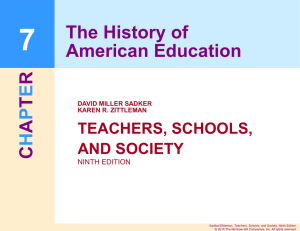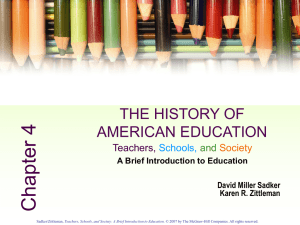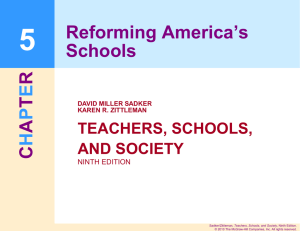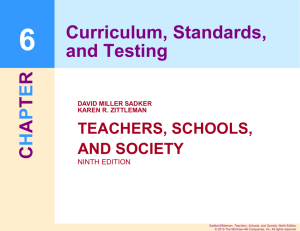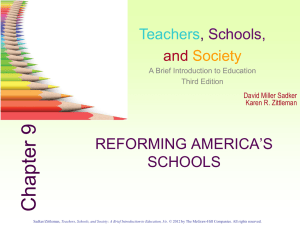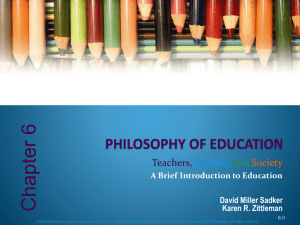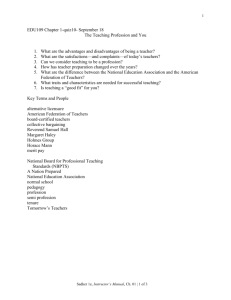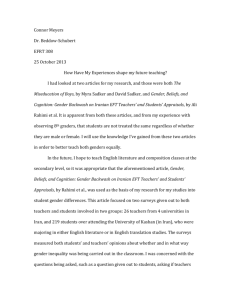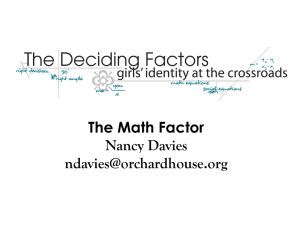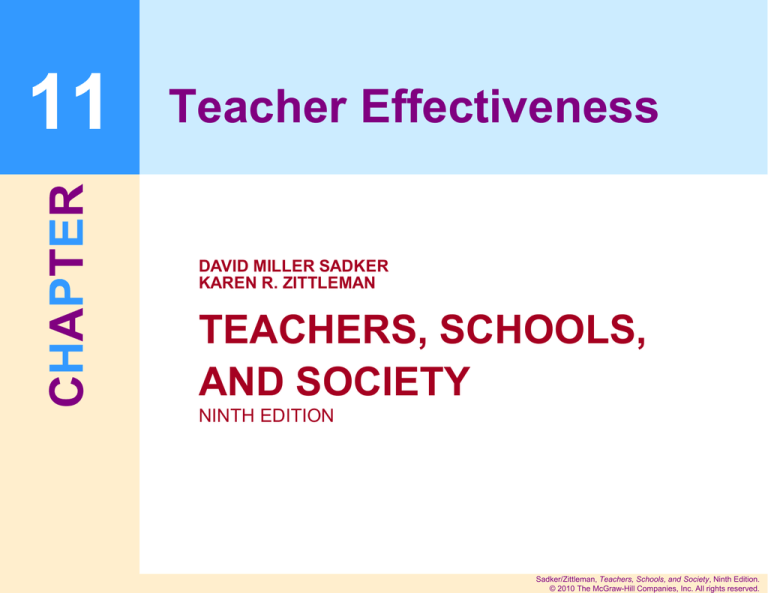
CHAPTER
11
Teacher Effectiveness
DAVID MILLER SADKER
KAREN R. ZITTLEMAN
TEACHERS, SCHOOLS,
AND SOCIETY
NINTH EDITION
Sadker/Zittleman, Teachers, Schools, and Society, Ninth Edition.
© 2010 The McGraw-Hill Companies, Inc. All rights reserved.
11.1 TIME ON TASK
Allocated Time
Amount of time scheduled for a
subject
Engaged Time
Allocated time in which
students are actively involved
with subject matter
Academic Learning
Time (ALT)
Engaged time with high student
success rate
Sadker/Zittleman, Teachers, Schools, and Society, Ninth Edition.
© 2010 The McGraw-Hill Companies, Inc. All rights reserved.
11.2 HIGH SUCCESS RATE
Engaged Time + High Success Rate =
Academic Learning Time
How can you tell whether students are performing at a high
success rate?
Guidelines:
• At least _____%* of teacher questions should result
in accurate student answers.
(Important for younger students and for those needing more time.)
• During independent practice, the success rate
should be almost _____%**.
*70%
**100%
Jere Brophy and Carolyn Evertson, Learning from Teaching: A Developmental Perspective (Boston: Allyn & Bacon, 1976). See also R. Marliave and
J. Filby, “Success Rates: A Measure of Task Appropriateness,” in C. W. Fischer and D. Berliner (eds.), Perspectives on Instructional Time (New
York: Longman, 1986); Gary Borich, Effective Teaching Methods (Columbus, OH: Merrill, 1988); Richard Kindsvatter et al., Dynamics of Effective
Teaching (New York: Longman, 1992).
Sadker/Zittleman, Teachers, Schools, and Society, Ninth Edition.
© 2010 The McGraw-Hill Companies, Inc. All rights reserved.
11.3 HIGH SUCCESS RATE (Continued)
In theory…
High Success Rate = Achievement
In reality…
Students are often
working at levels of failure.
In one study, 14% of the time, student answers to teacher
questions were 100 percent wrong.a
Researcher Jere Brophy concludes that teachers have a
tendency to assign tasks that are too difficult, rather than
too easy.b
aGary
Davis and Margaret Thomas, Effective Schools and Effective Teachers (Boston: Allyn & Bacon, 1989).
bJere
Brophy, “Classroom Organization and Management,” The Elementary School Journal 83, no. 4 (1983).
Sadker/Zittleman, Teachers, Schools, and Society, Ninth Edition.
© 2010 The McGraw-Hill Companies, Inc. All rights reserved.
JACOB KOUNIN’S PATTERNS TO AVOID DURING
11.4
TIMES OF TRANSITION
Flip-flops
Teacher terminates one activity, begins
another, then returns to the original activity
Overdwelling
Teacher spends more time than is necessary
to correct an infraction of classroom rules
Fragmentation Teacher breaks directions into choppy steps
instead of one fluid unit
Thrusts
Teacher interrupts classroom momentum
with random, unrelated comments
Dangles
Teacher begins a thought, then leaves it
hanging without completion
Sadker/Zittleman, Teachers, Schools, and Society, Ninth Edition.
© 2010 The McGraw-Hill Companies, Inc. All rights reserved.
11.5 MODELS OF CLASSROOM MANAGEMENT
Advocate
Main Focus
Belief System
Lee and
Marlene
Canter
Assertive Discipline Students deserve a safe and productive learning climate, and it is
the teacher’s job to provide it. Each student is taught how to
behave responsibly through clear rules and consequences. When
expectations are not met, students know that the teacher will
mete out consequences.
Curwin and Discipline with
Mendler
Dignity
Students should always be treated with dignity, even when they
misbehave. Interesting learning activities, positive reinforcement
and opportunities for student success keep students on track,
especially students with a history of misbehavior.
Barbara
Coloroso
Developing Inner
Control and
Discipline
Students need to take responsibility for their actions to develop
their inner discipline. If students are messy, they need to learn to
clean up after themselves. If they are too noisy, they need to
develop strategies to allow others to do their work.
Rudolf
Dreikurs
Collaborative
Decision Making
and Belonging
The key in this approach is to identify the motivation behind
misbehavior, and within a classroom community, to help students
redirect their behavior in a positive way.
Haim
Ginott
Communications
You speak to students as you, the teacher, would want to be
spoken to. Model desirable behaviors and maintain your calm as
a teacher. Focus on what needs to be done rather than on what
was done wrong.
Table 11.1
Source: Carol M. Charles. Building Classroom Discipline (Boston: Allyn & Bacon) 2007.
Sadker/Zittleman, Teachers, Schools, and Society, Ninth Edition.
© 2010 The McGraw-Hill Companies, Inc. All rights reserved.
11.6 MODELS OF CLASSROOM MANAGEMENT
(Continued)
Advocate
Main Focus
Belief System
William
Glasser
Student
Satisfaction
The teacher meets with the class to discuss not only behavior
rules, but the curriculum being taught. The teacher plans
meaningful work for the students and holds them to high
standards. Students feel a part of the school, possessing a sense
of fun, power, and independence.
Thomas
Gordon
Discipline as
Control
Students are involved in making the rules about classroom life
and procedures, and the problem owners are identified – that is,
those who are bothered by certain behaviors. The class as a
group works to resolve these issues.
Jacob
Kounin
Engagement and
Supervision
Student misbehavior is reduced by engaging lessons, and the
teacher’s watchful monitoring skills keep students on track.
Redl and
Group Dynamics
Wattenberg
Group dynamics, insights and peer influence are used to control
misbehavior. The causes of any misbehavior are diagnosed and
appropriate consequences are applied.
B. F.
Skinner
Desired behaviors are encouraged by immediately awarding
positive reinforcement. Undesirable behaviors are ignored.
Table 11.1
Behavior
Modification
Source: Carol M. Charles. Building Classroom Discipline (Boston: Allyn & Bacon) 2007.
Sadker/Zittleman, Teachers, Schools, and Society, Ninth Edition.
© 2010 The McGraw-Hill Companies, Inc. All rights reserved.
PEDAGOGICAL CYCLE AND
11.7
SAMPLE CLASSROOM DIALOGUE
Figure 11.2
Sadker/Zittleman, Teachers, Schools, and Society, Ninth Edition.
© 2010 The McGraw-Hill Companies, Inc. All rights reserved.
BLOOM’S TAXONOMY APPLIED TO
11.8
QUESTIONING LEVELS
Level I:
Knowledge
Recall information; rely on memory or senses to
provide answer
Level II:
Comprehension
Students go beyond simple recall; demonstrate
ability to arrange and organize previously learned
information mentally
Level III:
Application
Apply previously learned information to answer a
problem
Level IV:
Analysis
Use three kinds of cognitive processes:
1. Identify causes, reasons, or motives
2. Reach a conclusion
3. Find evidence to support a conclusion
Level V
or VI:
Synthesis/Creation Develop original communication, make a
prediction, and solve problems with many
possible answers
Level VI
or V:
Evaluation
Judge the merits of an aesthetic work, idea, or
solution to a problem
Sadker/Zittleman, Teachers, Schools, and Society, Ninth Edition.
© 2010 The McGraw-Hill Companies, Inc. All rights reserved.
11.9 BLOOM’S TAXONOMY
Student Generated Responses
Key Words or Examples
Level I
Knowledge
Level II
Comprehension
Level III
Application
Level IV
Analysis
Level V
or VI
Synthesis/Creation
Level VI
or V
Evaluation
Sadker/Zittleman, Teachers, Schools, and Society, Ninth Edition.
© 2010 The McGraw-Hill Companies, Inc. All rights reserved.
11.10 WAIT TIME: CHANGES IN STUDENT BEHAVIOR
• Longer responses
• Statements supported with evidence
• Speculative thinking increases
• More student questions
• Fewer failures to respond
• More students participate
• Fewer discipline problems
• Better performance on higher-order thinking skills
Sadker/Zittleman, Teachers, Schools, and Society, Ninth Edition.
© 2010 The McGraw-Hill Companies, Inc. All rights reserved.
11.11 WAIT TIME: CHANGES IN TEACHER BEHAVIOR
• Comments more fluent
• Discussion more logical
• More higher-order questions
• Higher expectations of students
Sadker/Zittleman, Teachers, Schools, and Society, Ninth Edition.
© 2010 The McGraw-Hill Companies, Inc. All rights reserved.
11.12 TEACHER REACTIONS
Figure 11.3
Sadker/Zittleman, Teachers, Schools, and Society, Ninth Edition.
© 2010 The McGraw-Hill Companies, Inc. All rights reserved.
11.13 EFFECTIVE USE OF PRAISE
Praise works best when:
• It is contingent upon student performance
• It is specific
• It is sincere
• It informs students of their competence and the
importance of their accomplishments
• It attributes success to ability or effort
• It uses past performance as context for present
performance
Sadker/Zittleman, Teachers, Schools, and Society, Ninth Edition.
© 2010 The McGraw-Hill Companies, Inc. All rights reserved.
11.14 EFFECTIVE USE OF FEEDBACK
Constructive feedback works best when:
• It is specific and contingent upon student performance
• It focuses on student performance, not personality
• It provides a clear blueprint for improvement
• It is an environment that tells a student mistakes are
acceptable
• It relates eventual success to effort
• It recognizes improvements in student performance
Sadker/Zittleman, Teachers, Schools, and Society, Ninth Edition.
© 2010 The McGraw-Hill Companies, Inc. All rights reserved.
11.15 STUDENT RATINGS OF TEACHING SKILLS
Source: The MetLife Survey of the American Teacher 2001: Key Elements of Quality Schools (New York: Harris Interactive, Inc., 2001).
Sadker/Zittleman, Teachers, Schools, and Society, Ninth Edition.
© 2010 The McGraw-Hill Companies, Inc. All rights reserved.
11.16 FIVE MODELS OF INSTRUCTION
TERM
Student Generated Key Ideas
Direct Teaching
Cooperative Learning
Mastery Learning
Problem-Based Learning
Differentiated Instruction
Sadker/Zittleman, Teachers, Schools, and Society, Ninth Edition.
© 2010 The McGraw-Hill Companies, Inc. All rights reserved.
11.17 TEACHING THAT WORKS
Good teachers…
•
Know their subject matter
•
Are enthusiastic about teaching and their subject area
•
Develop deep rather than shallow knowledge
•
Connect new learning to prior knowledge
•
Spend the major part of class time on academic activities
•
Teach content at a level that ensures a high rate of success
•
Are organized
•
Structure learning experiences carefully
•
Ensure that students have sufficient time to practice skills
•
Clearly present both directions and content information
Sadker/Zittleman, Teachers, Schools, and Society, Ninth Edition.
© 2010 The McGraw-Hill Companies, Inc. All rights reserved.
11.18 TEACHING THAT WORKS (Continued)
Good teachers…
•
Maintain high student interest and engagement
•
Actively monitor student progress
•
Involve all students (not just volunteers) in discussions
•
Ask both higher- and lower-order questions appropriate to the
objective of the lesson
•
Use adequate wait time
•
Provide clear academic feedback
•
Vary student activities and procedures
•
Hold high expectations for students
•
Have high regard for students and treat them with respect
•
Build classroom learning communities
Sadker/Zittleman, Teachers, Schools, and Society, Ninth Edition.
© 2010 The McGraw-Hill Companies, Inc. All rights reserved.

